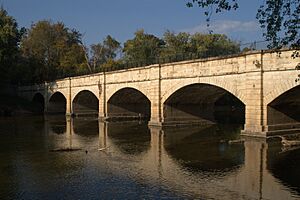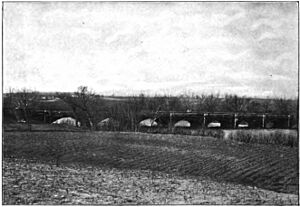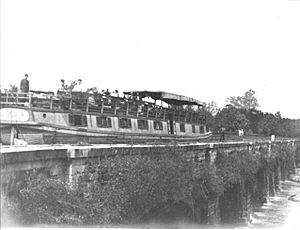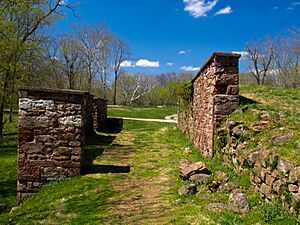Monocacy Aqueduct facts for kids
The Monocacy Aqueduct is the biggest aqueduct on the Chesapeake and Ohio Canal. It crosses the Monocacy River in Frederick County, Maryland, USA. This amazing structure is 438 feet (133.5 meters) long. It was built between 1829 and 1833. The cost was about US$127,900.
Contents
What is the Monocacy Aqueduct?
The aqueduct is made of strong stone. It has a waterway that is 19 feet wide at the bottom. The top of the waterway is 20 feet wide. The path where mules walked to pull boats is 8 feet wide. The wall on the upstream side is 6 feet wide.
How the Aqueduct was Designed
Benjamin Wright, the main engineer for the canal, designed the aqueduct. His plans included 6 piers (supports) and 2 abutments (end supports). It has 7 arches, each 54 feet wide. The piers are 10 feet thick. Most of the stone blocks came from a quarry near Sugarloaf Mountain.
History of the Monocacy Aqueduct
Building the aqueduct started in 1829. Several companies worked on it over the years. Hovey and Legg started the first contract. Then Asher Osbourn took over. By the end of 1830, Byrne and Lebaron were in charge.
Saving the Aqueduct During the Civil War
During the American Civil War, the Union Army used the canal. They moved war supplies and troops along it. Because of this, the canal and its aqueducts were often attacked. Soldiers from the Confederate Army tried to damage them.
Thomas Walter was a lock keeper on the canal. He supported the South but loved the Monocacy Aqueduct even more. In September 1862, Confederate General D. H. Hill planned to destroy it. This was during the Antietam campaign. Walter convinced General Hill that draining the canal would stop boat traffic just as well. This saved the aqueduct from being blown up.
A few days later, another Confederate group tried to blow up the aqueduct. But the stone was too hard. They could not drill enough holes for explosives. So, the Monocacy Aqueduct survived the war.
The Old Granary
Like at Whites Ferry, a granary was built here. A granary is a building for storing grain. This one had three storage areas. It also had two passages for boats. Today, you can still see the remains of this old granary next to the parking lot.
The Aqueduct Today
The Monocacy Aqueduct is now part of the Chesapeake and Ohio Canal National Historical Park. The National Park Service takes care of it.
Restoring the Aqueduct
In the early 1970s, floods damaged parts of the canal. Hurricane Agnes caused a lot of harm. Engineers designed a special system to make the aqueduct stronger. They used steel bands and rods to stabilize the structure.
The National Park Service and its supporters wanted to fully restore the aqueduct. They studied what was needed and how much it would cost. From 2004 to 2005, the aqueduct was carefully restored. It now looks like it did when it was first built. The restored aqueduct was officially celebrated in May 2005.






